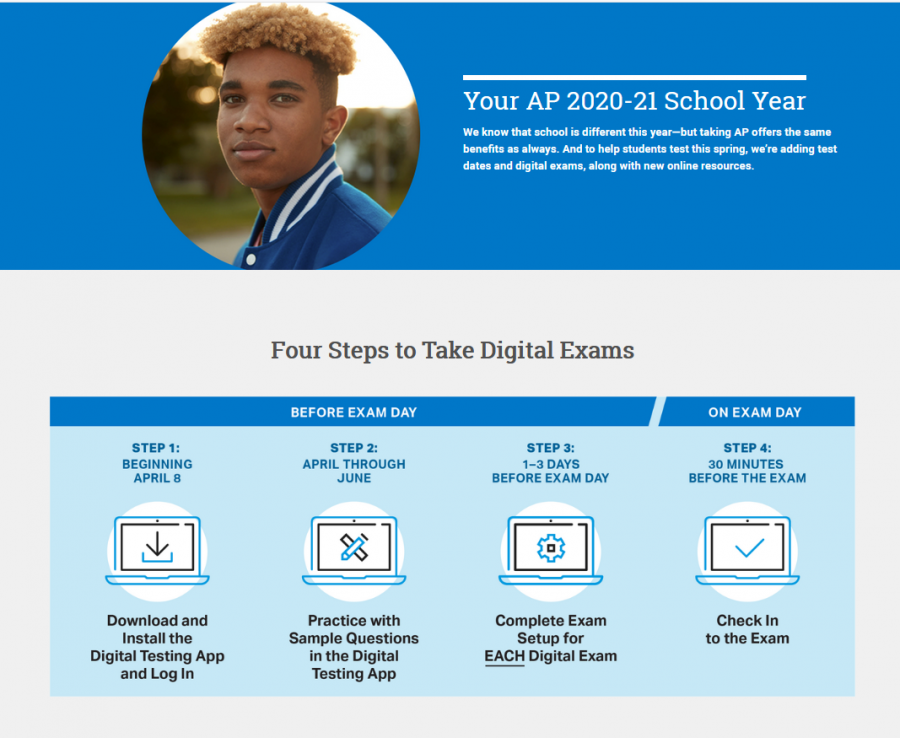College Board offers an online, in-person option for AP exams
Photo by Photo by Sasha Kek
For the 2021 digital AP exams, the College Board has made a few changes from last year’s exams. “This year with digital, they are not allowing you to write out essays or write out answers, like last year, when you were able to write them out and upload them with your phone – that’s not allowed this year,” Laura Will, Testing Assessment Coordinator, said. Everything has to be typed out, so it just mirrors the paper exam.”
AP testing started last week, and this year the College Board gave two options to take the exams: in-person and online.
“The tests are basically the same, but the only difference that I can see is that one is paper and pencil, and one is digital – the actual content is the same,” Laura Will, Testing Assessment Coordinator, said. “There are multiple choices on both tests. There’s free response and/or essays on both, so it very much mirrors what you’re going to be doing in-person, but the difference is you need to use a keyboard.”
Unlike last year’s digital exams, students will need to download the 2021 Digital AP Exams app. The online exams started this week during Administration 2, with a retake option starting the week of June 1 if there are any issues submitting the exam.
“There’s four steps: [students] need to download the app; they need to register with a personal laptop or a personal home computer – even students that are testing paper and pencil, I’m encouraging them to learn how to test digitally in case they can’t show up for paper; then three days before the exam, you need to go in and register for that exam. On the day of the exam, 30 minutes prior to the exam, you log in. It gives you a whole list of instructions, and you kind of follow through all of that and get ready for the exam.”
Although most students have been working digitally for the majority of the year, Will believes the main reason the College Board is offering an in-person testing option is for students who are back in-person.
“I met with several coordinators from all over the other night and many schools aren’t doing paper and pencil at all – their kids are not even back in school and they’ve remained digital and remote all year. I think it’s great that we came back, and to have almost 90 percent of our students, that’s a lot of remote kids coming in to test paper and pencil,” Will said. “We have a huge percentage of our remote kids coming into the test in-person and I think that’s why the College Board offered it. There are some states and some schools that are back 100% in-person, and I think they just wanted to give the kids every opportunity.”
Matthew Nerenberg, freshman AP World History student, is one of the students who decided to take the in-person exam, which he found more favorable after hearing “the horror stories from people talking about their previous exam,” in reference to the technology issues some students experienced during the 2020 online exams.
“Originally I wasn’t actually going to take the in-person one, I was actually going to take the e-learning one, but then actually what happened was my parents both got vaccinated and we decided that the cons of technology problems and bad possibilities are more for the e-learning one, than there are for the in-person,” Nerenberg said. “There’s just so many possibilities of it going wrong that it just seemed easier that if I’m going to put the effort in to doing this big long test, I want to make sure at least I have a chance of getting something out of it.”
Will says she does not see neither the digital nor in-person exam as more advantageous than the other, despite some student impressions.
“I think a lot of students might think there is, that there might be an opportunity if you’re not in the same room with your teacher [to cheat], but the College Board has put so many safeguards into place,” Will said. “Just based on what I know from last year, the only disadvantage I can see [for the digital exam] at this point, and I hope it doesn’t happen is AP tests are worldwide, every test [is] at the same time. If you have the entire world testing online at the same time, the disadvantage there is that your test may not go through because the network may be too busy. The College Board has told us that they have upgraded, so they’re hoping that that doesn’t happen.”
Both Will and Nerenberg find the in-person exam to be a “better option,” mostly because there is a 100 percent chance the exam will be submitted, which is not a certainty for the digital exam.
“I’d say the in-person option is probably better just because of the lack of cons, and also the fact that they’ve been doing the in-person one for many, many years, whereas they’ve only been doing this at-home one for maybe one or two years,” Nerenberg said. “I think just the stability and the fact that instead of it being more up to chance and it’s more routine, I think [the in-person exam] just offers less probability of something going bad.”
Even though she believes the in-person exam is a more favorable option, Will says students should learn how to test digitally nonetheless as she sees exams going online in the future.
“The way I see testing going, all the testing, like the ACT, is pushing towards a more digital format. SAT, not so much, but I see this trend where they’re pushing for a digital format for testing, so I would probably recommend that, even if you don’t take the test [digitally], go in and see it and learn about it,” Will said. “I just see testing going digitally, whether it’s in school or at home.”

This is Sasha’s third and final year working with the Bear Facts staff as the LZ Life Editor. Aside from helping Bear Facts run smoothly, you can find...

